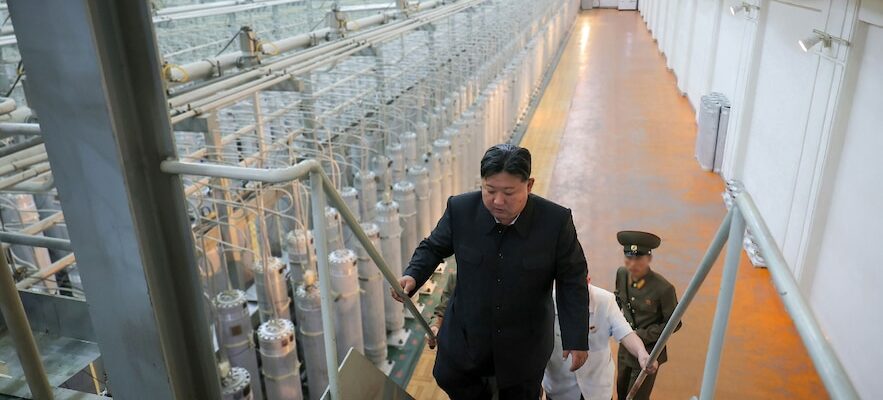This is a first. During a visit this Friday, September 13, by North Korean leader Kim Jong-un, North Korea published images presented as those of its uranium enrichment facilities. In these photos, we can see centrifuges that appear quite modern and efficient according to observers, which could revise upwards the estimates of the number of nuclear weapons present in the country. Pyongyang, which carried out its first nuclear test in 2006 and is the subject of numerous sanctions from the United Nations for its banned weapons programs, had never publicly shown these facilities necessary for the manufacture of nuclear warheads, thanks to high-speed centrifuges.
Kim Jong-un visited the nuclear weapons institute and a military base for producing nuclear materials, the official KCNA news agency said, without specifying where the facilities are located or when the visit took place. The North Korean leader “stressed the need to further increase the number of centrifuges to exponentially increase self-defense nuclear weapons,” the agency reported, releasing footage of Kim Jong-un inspecting rows of centrifuges.
Kim Jong-un “has familiarized himself with the production of nuclear warheads” and nuclear materials, the agency said. The leader urged “promoting the introduction of a new type of centrifuge” […] to strengthen the foundation for producing nuclear materials for military use.” The North Korean leader also called for “setting a higher long-term target for producing necessary nuclear materials,” KCNA added. North Korea’s nuclear weapons programs are under UN sanctions, but the country ignores those restrictions, thanks in part to the support of its allies Russia and China.
Undated photo released by North Korea’s official KCNA news agency on September 13, 2024, shows North Korean leader Kim Jong Un visiting a uranium enrichment site at an unspecified location in North Korea.
© / afp.com/STR
A message for the United States?
Experts say the release of images of the uranium enrichment facilities could be aimed at influencing the US presidential election in November. The images are “a message to the next administration” that “it will be impossible to denuclearize North Korea,” Hong Min, a senior analyst at the Korea Institute for National Unification, told AFP. “It is also a message asking other countries to recognize North Korea as a nuclear state,” he added. However, the analyst said the exposure is unlikely to be quickly followed by another nuclear test.
According to information released Wednesday by 38 North, a North Korea analysis program run by the Stimson Center think tank, North Korea’s main nuclear test site was damaged by flooding following heavy rains in late July. The site “is in very bad shape.” “All the roads and railways have been destroyed by the rains and the ground is very fragile,” Hong Min said.
Relations between Seoul and Pyongyang are at an all-time low, with the North recently announcing the deployment of 250 ballistic missile launchers on its southern border. North Korea has been dropping large quantities of garbage-laden balloons in recent months, with another batch last week. On Thursday, Seoul said North Korea had fired several “short-range ballistic missiles” into the sea, its first major weapons test since early July. But the KCNA news agency said Friday that it was a test of a “new type of 600mm multiple rocket launcher.”
